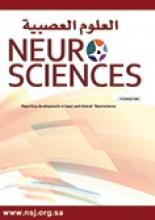Abstract
OBJECTIVE: To assess the value of trigeminal somatosensory evoked potentials (TSEP) in evaluating toxicity of trichloroethylene to the trigeminal nerve.
METHODS: Trichloroethylene (TCE), an excellent fat solvent largely used in industry, has a neurotoxic effect particularly on the trigeminal nerve. In March 2002, several TCE-exposed workers presented to Habib Bourguiba University Hospital, Sfax, Tunisia, for burned or numbness of the face. Twenty-three workers manipulating TCE underwent clinical, biological and toxicological assessment. Neurophysiologic study consisted of the measurement of the latencies and the amplitudes of TSEP in 23 exposed workers and 23 controls.
RESULTS: Abnormal TSEP were observed in 6 workers with clinical evidence of trigeminal involvement and in 9 asymptomatic workers. We observed a significant positive correlation between duration of exposure and the N2 latency (r=0.5, p<0.01) and P2 latency (r=0.6, p<0.02). The sensitivity of TSEP was 65% and the specificity was 100%.
CONCLUSION: Trigeminal somatosensory evoked potentials are a useful tool in the diagnosis and management of chronic neurological complications of TCE intoxication. Since alterations of TSEP precede clinical symptoms, trigeminal nerve involvement can be demonstrated at the infra-clinical stage.
- Copyright: © Neurosciences
Neurosciences is an Open Access journal and articles published are distributed under the terms of the Creative Commons Attribution-NonCommercial License (CC BY-NC). Readers may copy, distribute, and display the work for non-commercial purposes with the proper citation of the original work.






